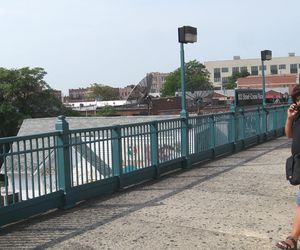103rd Street–Corona Plaza station
103 Street–Corona Plaza | |||||||
|---|---|---|---|---|---|---|---|
 Northbound platform | |||||||
| Station statistics | |||||||
| Address | 103rd Street & Roosevelt Avenue Queens, NY 11368 | ||||||
| Borough | Queens | ||||||
| Locale | Corona | ||||||
| Coordinates | 40°44′59.37″N 73°51′45.84″W / 40.7498250°N 73.8627333°W | ||||||
| Division | A (IRT)[1] | ||||||
| Line | IRT Flushing Line | ||||||
| Services | 7 | ||||||
| Transit | |||||||
| Structure | Elevated | ||||||
| Platforms | 2 side platforms | ||||||
| Tracks | 3 | ||||||
| Other information | |||||||
| Opened | April 21, 1917 | ||||||
| Opposite- direction transfer | Yes | ||||||
| Former/other names | Alburtis Avenue[2] 104th Street | ||||||
| Traffic | |||||||
| 2023 | 6,460,459[3] | ||||||
| Rank | 30 out of 423[3] | ||||||
| Station succession | |||||||
| Next north | Template:NYCS next | ||||||
| Next south | Template:NYCS next | ||||||
| |||||||
| |||||||
| |||||||
103rd Street–Corona Plaza is a local station on the IRT Flushing Line of the New York City Subway, located at the intersection of 103rd Street and Roosevelt Avenue.[5] It is served by the 7 train at all times.[6]
History
Track layout | |||||||||||||||||||||||||||||||||||||||||||||||||||||||||||||||
|---|---|---|---|---|---|---|---|---|---|---|---|---|---|---|---|---|---|---|---|---|---|---|---|---|---|---|---|---|---|---|---|---|---|---|---|---|---|---|---|---|---|---|---|---|---|---|---|---|---|---|---|---|---|---|---|---|---|---|---|---|---|---|---|
| |||||||||||||||||||||||||||||||||||||||||||||||||||||||||||||||
This station opened on April 21, 1917, as Alburtis Avenue, as the easternmost station of an extension of the Flushing line past Queensboro Plaza.[2] It was later renamed 104th Street, giving the possibility of a sealed exit at the north end, before taking its current name of 103rd Street–Corona Plaza. This station still contains signs, which have been covered, showing Alburtis Avenue. This station was the eastern terminal for the joint BMT and IRT services on the line until the extension to 111th Street opened on October 13, 1925.[2][7][8][9]
The platforms at 103rd Street were extended in 1955–1956 to accommodate 11-car trains.[10]
Station layout
| Platform level | ||
| Side platform | ||
| Southbound local | ← | |
| Peak-direction express | ← | |
| Northbound local | | |
| Side platform | ||
| Mezzanine | Fare control, station agent, MetroCard machines | |
| Ground | Street level | Entrances/exits |

This elevated station has three tracks and two side platforms.[11] The center track is used by the rush hour peak direction <7> express service.[6] Both platforms have beige windscreens and brown canopies supported by green frames and support columns in the center and green waist-high steel fences at both ends. The station names are in the standard black plates in white lettering, though some lampposts at both ends have their original white signs in black letting.[9][12]
Exits
This station's only entrance/exit is an elevated station house beneath the tracks. A pair of staircases from either side of Roosevelt Avenue between 103rd and 104th Streets go up to the station house, where there is a token booth in the center and a turnstile bank on either side.[13] Both turnstile banks lead to a wooden waiting area/crossunder and have a single staircase going up to either platform.[8][9]
References
- ^ "Glossary". Second Avenue Subway Supplemental Draft Environmental Impact Statement (SDEIS) (PDF). Vol. 1. Metropolitan Transportation Authority. March 4, 2003. pp. 1–2. Archived from the original (PDF) on February 26, 2021. Retrieved January 1, 2021.
- ^ a b c "NEW RAPID TRANSIT COMMISSION PREPARING PLANS FOR EXTENSION OF CORONA LINE TO FLUSHING; Board of Estimate Has Authorized Extension of Line From Corona to New Storage Yards Near Flushing River--Queensboro Subway to Have Connection With Proposed Eighth Avenue Line Near Times Square" (PDF). The New York Times. June 12, 1921. Retrieved September 18, 2015.
- ^ a b "Annual Subway Ridership (2018–2023)". Metropolitan Transportation Authority. 2023. Retrieved April 20, 2024.
- ^ "Annual Subway Ridership (2018–2023)". Metropolitan Transportation Authority. 2023. Retrieved April 20, 2024.
- ^ "MTA Neighborhood Maps: Corona" (PDF). Metropolitan Transportation Authority. 2015. Retrieved September 20, 2015.
- ^ a b "7 Subway Timetable, Effective June 26, 2023". Metropolitan Transportation Authority. Retrieved August 26, 2023.
- ^ "First Trains to be Run on Flushing Tube Line Oct. 13: Shuttle Operation Ordered to 111th Street Station on New Extension". Newspapers.com. Brooklyn Daily Eagle. October 5, 1925. p. 8. Retrieved September 20, 2015.
- ^ a b "www.nycsubway.org: IRT Flushing Line". www.nycsubway.org. Retrieved February 18, 2016.
- ^ a b c "7 Train". August 11, 2014. Archived from the original on August 11, 2014. Retrieved February 18, 2016.
{{cite web}}: Unknown parameter|deadurl=ignored (|url-status=suggested) (help) - ^ Authority, New York City Transit (January 1, 1955). Minutes and Proceedings.
- ^ Dougherty, Peter (2006) [2002]. Tracks of the New York City Subway 2006 (3rd ed.). Dougherty. OCLC 49777633 – via Google Books.
- ^ Cox, Jeremiah. "103 Street-Corona Plaza (7) - The SubwayNut". www.subwaynut.com. Retrieved February 18, 2016.
- ^ "MTA Neighborhood Maps: Corona" (PDF). Metropolitan Transportation Authority. 2015. Retrieved September 20, 2015.




